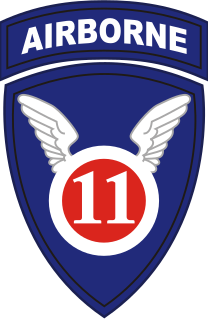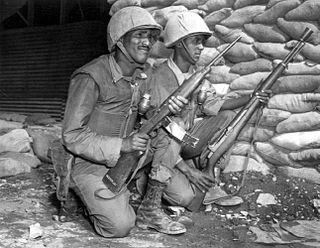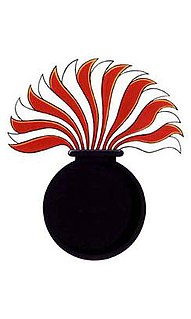 W
WThe 4th Princess Louise Dragoon Guards is an inactive armoured regiment of the Canadian militia.
 W
WThe 11th Airborne Division ("Angels") was a United States Army airborne formation, first activated on 25 February 1943, during World War II. Consisting of one parachute and two glider infantry regiments, with supporting troops, the division underwent rigorous training throughout 1943. It played a vital role in the successful Knollwood Maneuver, which was organized to determine the viability of large-scale American airborne formations after their utility had been called into question following a disappointing performance during the Allied invasion of Sicily.
 W
WThe 19th Alberta Dragoons originated in Edmonton, Alberta on 1 February 1908, when the 19th The Alberta Mounted Rifles were authorized to be formed and was redesignated as the 19th Alberta Dragoons on 3 January 1911. On 16 February 1936, it was amalgamated with The Alberta Mounted Rifles. It was redesignated the 19th (Reserve) Alberta Dragoons on 7 November 1940. On 1 April 1946, it was amalgamated with the 2nd (Reserve) Battalion, The Edmonton Fusiliers and redesignated as the 19th (Alberta) Armoured Car Regiment, RCAC. It was redesignated the 19th Alberta Armoured Car Regiment on 4 February 1949, the 19th Alberta Dragoons on 1 November 1954 and the 19th Alberta Dragoons on 19 May 1958. It was reduced to nil strength and transferred to the Supplementary Order of Battle on 28 February 1965.
 W
WThe 92nd Training Centre was a formation of the Ukrainian Ground Forces, that drew most of its history from the 92nd Guards Rifle Division, that became the 92nd Guards Training Motor Rifle Division in 1965.
 W
WThe 65th Air Division is an inactive United States Air Force organization. Its last assignment was with United States Air Forces in Europe, assigned to Seventeenth Air Force, being stationed at Lindsey Air Station, Germany. It was inactivated on 30 June 1991.
 W
WThe 3918th Strategic Wing is an inactive United States Air Force unit, discontinued on 31 March 1965.
 W
WThe 3920th Strategic Wing is an inactive United States Air Force unit, discontinued on 31 March 1965. The 3920th SW was a non-flying ground service support element for the 7th Air Division (AD) of Strategic Air Command (SAC), based at RAF Brize Norton, Oxfordshire, in the United Kingdom. It was established on 1 December 1952 as the 3920th Air Base Group. When activated, the wing assumed the resources of the 7503d Air Support Wing, which had been established on 25 May 1951. Throughout its existence it was controlled by Strategic Air Command and served as the host for deployed SAC bombardment, strategic reconnaissance, and air refueling units.
 W
WThe Bermuda Volunteer Rifle Corps (BVRC) was created in 1894 as an all-white, racially segregated reserve for the Regular Army infantry component of the Bermuda Garrison. Renamed the Bermuda Rifles in 1951, it was amalgamated into the Bermuda Regiment in 1965.
The Highland Light Infantry of Canada was an infantry regiment of the Canadian Army. Founded in 1886 as the 29th Waterloo Battalion of Infantry it went through several name changes including, in 1900, the 29th Waterloo Regiment and in 1915, the 29th Regiment . It acquired its present title in 1920. In 1954, as a result of the Kennedy Report on the Reserve Army, this regiment was amalgamated with The Perth Regiment to form The Perth and Waterloo Regiment. However, this amalgamation was undone in 1957 and the Highland Light Infantry of Canada resumed its regimental identity. In 1965 it amalgamated with the Scots Fusiliers of Canada and was renamed the Highland Fusiliers of Canada.
 W
WThe Irish Fusiliers of Canada was an infantry regiment of the Canadian Army.
 W
WThe Kagnew Battalions were a number of military units from the Imperial Ethiopian Army which fought as part of United Nations Command in the Korean War (1950–53). The battalions rotated yearly, with the First Kagnew Battalion arriving at the front in 1951. The Third Kagnew Battalion which arrived in 1953, stayed through the signing of the armistice into 1954. Over the next two years more Ethiopians guarded the stalemate in Korea as part of the Fourth Kagnew Battalion and the Fifth Kagnew Company. Even though some publications indicate Ethiopians remained in Korea until 1965, in fact they remained a part of the United Nations Command until 1975. Members of Kagnew Battalion were, with few exceptions, drawn from the Ethiopian Imperial Bodyguard Division.
 W
WNo. 49 Squadron was a bomber squadron of the Royal Air Force from 1938 to 1965. They were the first squadron to receive the Hampden in September 1938.
 W
WThe Royal Army Service Corps (RASC) was a corps of the British Army responsible for land, coastal and lake transport, air despatch, barracks administration, the Army Fire Service, staffing headquarters' units, supply of food, water, fuel and domestic materials such as clothing, furniture and stationery and the supply of technical and military equipment. In 1965 its functions were divided between other Corps and the RASC ceased to exist; subsequently, in 1993, they in their turn became the "Forming Corps" of the Royal Logistic Corps.
 W
WThe Victoria Rifles of Canada was an infantry regiment of the Canadian Army that originated in Montreal, Quebec, on 22 January 1862, as The 3rd Battalion Volunteer Militia Rifles Canada. The regiment went through several changes of designation throughout its history. It was redesignated as the 3rd Battalion, The Victoria Volunteer Rifles of Montreal on 18 July 1862; as the 3rd Battalion Victoria Rifles of Canada on 5 December 1879; as the 3rd Regiment Victoria Rifles of Canada on 8 May 1900; as The Victoria Rifles of Canada on 29 March 1920; as Victoria Rifles of Canada on 15 November 1934; as the 2nd (Reserve) Battalion, Victoria Rifles of Canada on 7 November 1941; and finally Victoria Rifles of Canada on 1 June 1945. It was reduced to nil strength and transferred to the Supplementary Order of Battle on 5 March 1965.
 W
WThe Winnipeg Grenadiers was an infantry regiment of the Canadian Army formed on 1 April 1908 under General Order No. 20. Initially it was raised with headquarters at Morden, Manitoba, and companies at: A Company at Morden, B Company at Morden, C Company at Manitou, D Company at Carman, E Company at Roland, F Company at Pilot Mound, G Company at Cartwright and H Company at Boissevain. The unit did not have any active personnel enrolled at the formation.